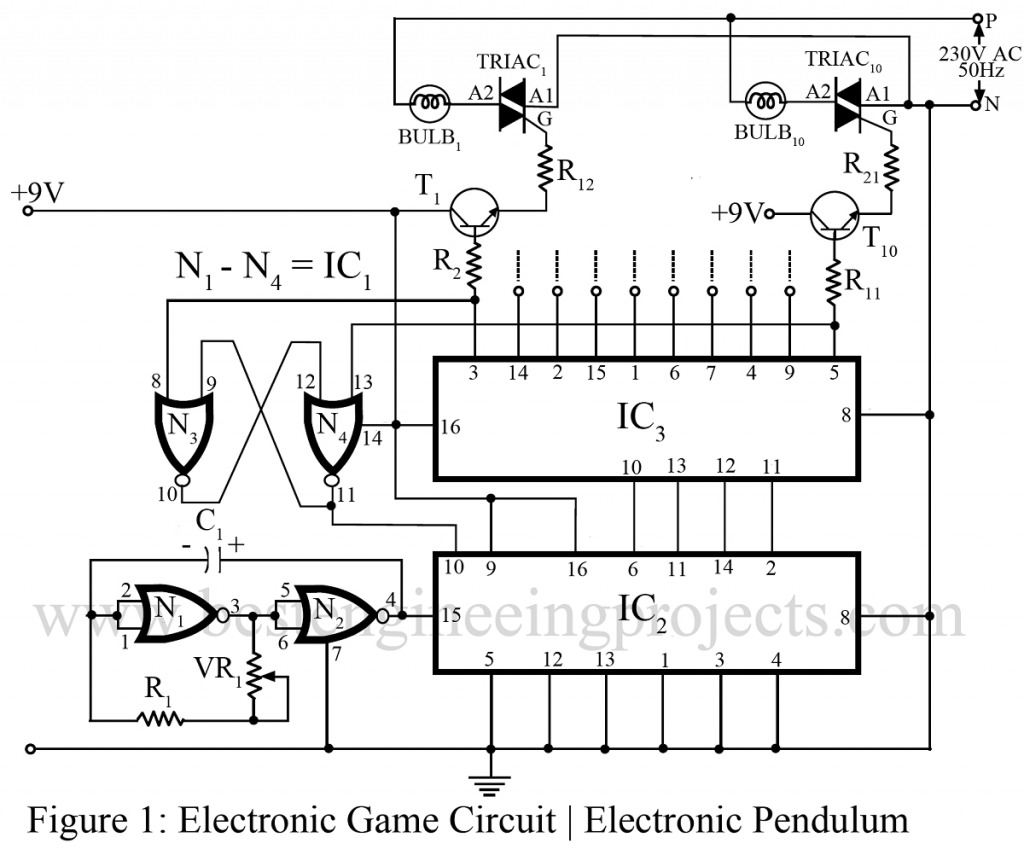Every person gets a pleasant feeling staring at pendulum when it is oscillating. This pendulum trick can be used in different ways to create a shimmering atmosphere. Electronic technologies guide us through people’s soul and thus help us to win their heart eventually. Here we have presented similar type of game circuit which is used to produce attention-grabbing phenomenon like “dashing light” and pendulum. It sounds quite interesting, don’t you feel so?
As everyone knows pendulum oscillates in to and fro motion about a vertical mean position. This process can be demonstrated with the aid often light bulbs, arranging them in a curved fashion to reflect the movement of pendulum. As we light those bulbs sequentially and simultaneously in both directions, first in one direction and then in other using this simple electronic pendulum circuit, we observe the pendulum effect. We must be careful enough to adjust the frequency of oscillator to a quite low value.
Circuit Description of Electronic Game Circuit | Electronic Pendulum
In order to generate dashing light effect, we use an arrangement of 19 bulbs connected such that bulb number 1 and 19, 2 and 18, 3 and 17, so on are in parallel. Unlike the pendulum effect, to create this effect, we must adjust the oscillator frequency to a comparatively high value.
In this electronic game circuit, the combination of NOR gates N1 and N2 form an oscillator whose period can be adjusted through pot-meter VR1 connected in between as shown in the figure.
The output of the oscillator i.e. combined NOR gates is given to the clock pin 15 of IC2 (CD4029). This pin of IC2 is a binary/BCD up-down counter. The counter counts up, as long as the pin 10 of IC2 is high (at logic 1). When the logic level changes to 0, it counts down. This process is explained in details below.
As shown in the electronic pendulum circuit diagram, the BCD outputs of IC2 are connected to IC3 (CD4028), which is a 1-of-10 decoder. As per sequential BCD inputs (up or down), outputs of IC3 goes high and then it triggers the TRIACs (TRIAC1 through TRIAC10) via corresponding transistors (T1 through T10) to light up the bulbs connected to them.
In similar way, when output at pin 3 of IC3 goes high, it raises the output of flip-flop formed by the NOR gates N3 and N4 to a high logic. This keeps the pin 10 of IC2 at logic 1, and thus the counter counts up. Consequently, when output of pin becomes high, the flip-flop is toggled and pin 10 of IC2 is pulled to logic 0, and then the counter starts counting down. This cycle repeats endlessly.
PARTS LIST OF ELECTRONIC GAME CIRCUIT | ELECTRONIC PENDULUM
| Resistor (all ¼-watt, ± 5% Carbon) |
| R1 – R11 = 10 KΩ
R12 – R21 = 330 Ω |
| Capacitor |
| C1 = 10 µF/16V (Electrolytic capacitor) |
| Semiconductors |
| IC1 = CD4001
IC2 = CD4029 IC3 = CD4028 TRIAC1 – TRIAC10 = 8T44 T1 – T10 = BC547 |
| Miscellaneous |
| BULB1 – BULB10 |
